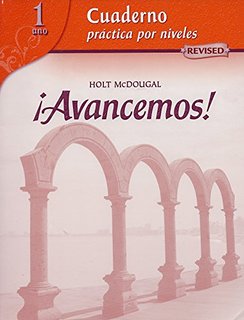
Avancemos: Cuaderno Práctica Por Niveles 1 (Revised)
1st Edition
ISBN: 9780618765935
Textbook solutions
All Solutions
Page 54: Gramatica B
Exercise 1
Step 1
1 of 3
Objective.
The objective of this exercise is to practise the use of the verb “tener”.
The objective of this exercise is to practise the use of the verb “tener”.
Step 2
2 of 3
Method.
By now, you have learned that the verb “tener” means “to have”. However, it can also be an element of the verbal periphrasis “tener que + infinitivo”. A verbal periphrasis is a construction made of at least two verbs: one is conjugated according to the grammatical subject and it receives an auxiliary – or modal – value, whilst the other remains impersonal – not conjugated – and is the main verb.
By now, you have learned that the verb “tener” means “to have”. However, it can also be an element of the verbal periphrasis “tener que + infinitivo”. A verbal periphrasis is a construction made of at least two verbs: one is conjugated according to the grammatical subject and it receives an auxiliary – or modal – value, whilst the other remains impersonal – not conjugated – and is the main verb.
For instance, in the phrase “tengo que estudiar”, “tener” is the modal verb and is conjugated according to the subject. This means that “I have to” do something. This “something” is contained in the impersonal verb, thus the whole phrase means that “I have to study”.
In this exercise, you will pay attention to whether there is a “que” following the verb or not. If so, this means that it is a verbal periphrasis, and if not, then it is a simple verb with the meaning “to have”. You may refer to the below solutions for further guidance.
Result
3 of 3
1. a. tiene
2. b. tienen
3. c. tenemos
4. c. tienes
2. b. tienen
3. c. tenemos
4. c. tienes
Exercise 2
Step 1
1 of 3
Objective.
The purpose of this exercise is to practise the use of the verbal periphrasis “tener que + infinitivo”.
The purpose of this exercise is to practise the use of the verbal periphrasis “tener que + infinitivo”.
Step 2
2 of 3
Method.
For this exercise, you are given key words: the grammatical subject, what the subject has to do and a marker of frequency. You will create full sentences based on these key words. You will link them by using the construction “tener que + infinitivo”. Remember that you will only conjugate the auxiliary verb (tener). Since you will be saying what they have to do, you will conjugate the verb in the present tense. Agree the verb with the grammatical subject in all applicable grammatical features. You may refer to the below solutions for further guidance.
For this exercise, you are given key words: the grammatical subject, what the subject has to do and a marker of frequency. You will create full sentences based on these key words. You will link them by using the construction “tener que + infinitivo”. Remember that you will only conjugate the auxiliary verb (tener). Since you will be saying what they have to do, you will conjugate the verb in the present tense. Agree the verb with the grammatical subject in all applicable grammatical features. You may refer to the below solutions for further guidance.
Result
3 of 3
1. María Elena y Nora tienen que estudiar mucho.
2. (Nosotros) siempre tenemos que usar la computadora.
3. (Yo) tengo que hablar con la maestra de vez en cuando.
4. Alejandro tiene que hacer la tarea muchas veces.
5. (Tú) tienes que leer el libro todos los días.
2. (Nosotros) siempre tenemos que usar la computadora.
3. (Yo) tengo que hablar con la maestra de vez en cuando.
4. Alejandro tiene que hacer la tarea muchas veces.
5. (Tú) tienes que leer el libro todos los días.
Exercise 3
Step 1
1 of 3
Objective.
The objective of this exercise is to practise the use of the verbal periphrasis “tener que + infinitivo”.
The objective of this exercise is to practise the use of the verbal periphrasis “tener que + infinitivo”.
Step 2
2 of 3
Method.
You will write three full sentences about what you have to do in your Spanish class. Use all of the vocabulary you have learned. You will use the present tense and conjugate the verb in the first person singular since it is a question that addresses yourself. Answers will vary from student to student, thus only refer to the below example as a reference of how your responses might look like.
You will write three full sentences about what you have to do in your Spanish class. Use all of the vocabulary you have learned. You will use the present tense and conjugate the verb in the first person singular since it is a question that addresses yourself. Answers will vary from student to student, thus only refer to the below example as a reference of how your responses might look like.
Step 3
3 of 3
Example.
Para la clase de español de hoy, tengo que tomar muchos apuntes. También tengo que leer y hablar en español. Tengo que estudiar mucho para sacar una buena nota.
unlock

